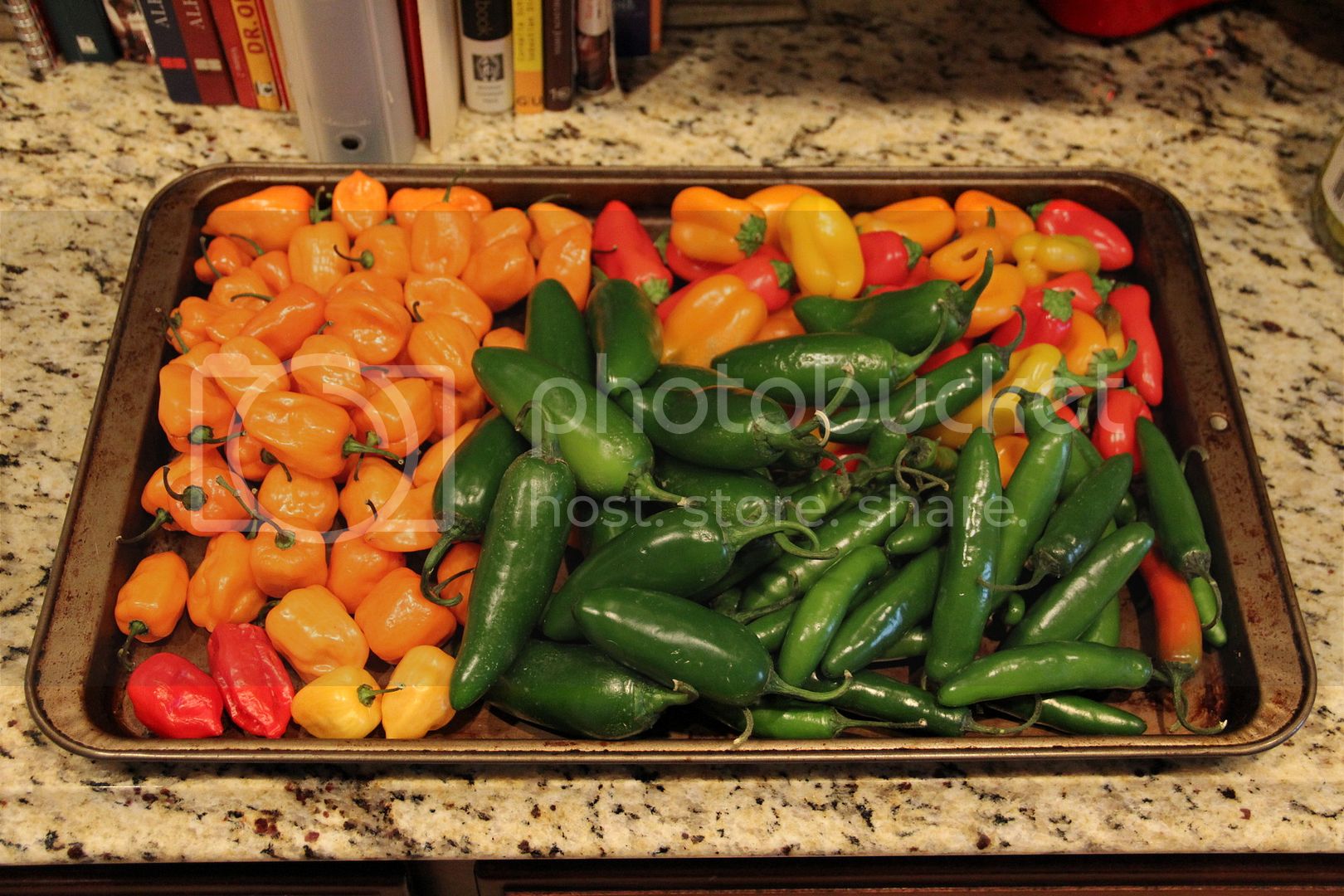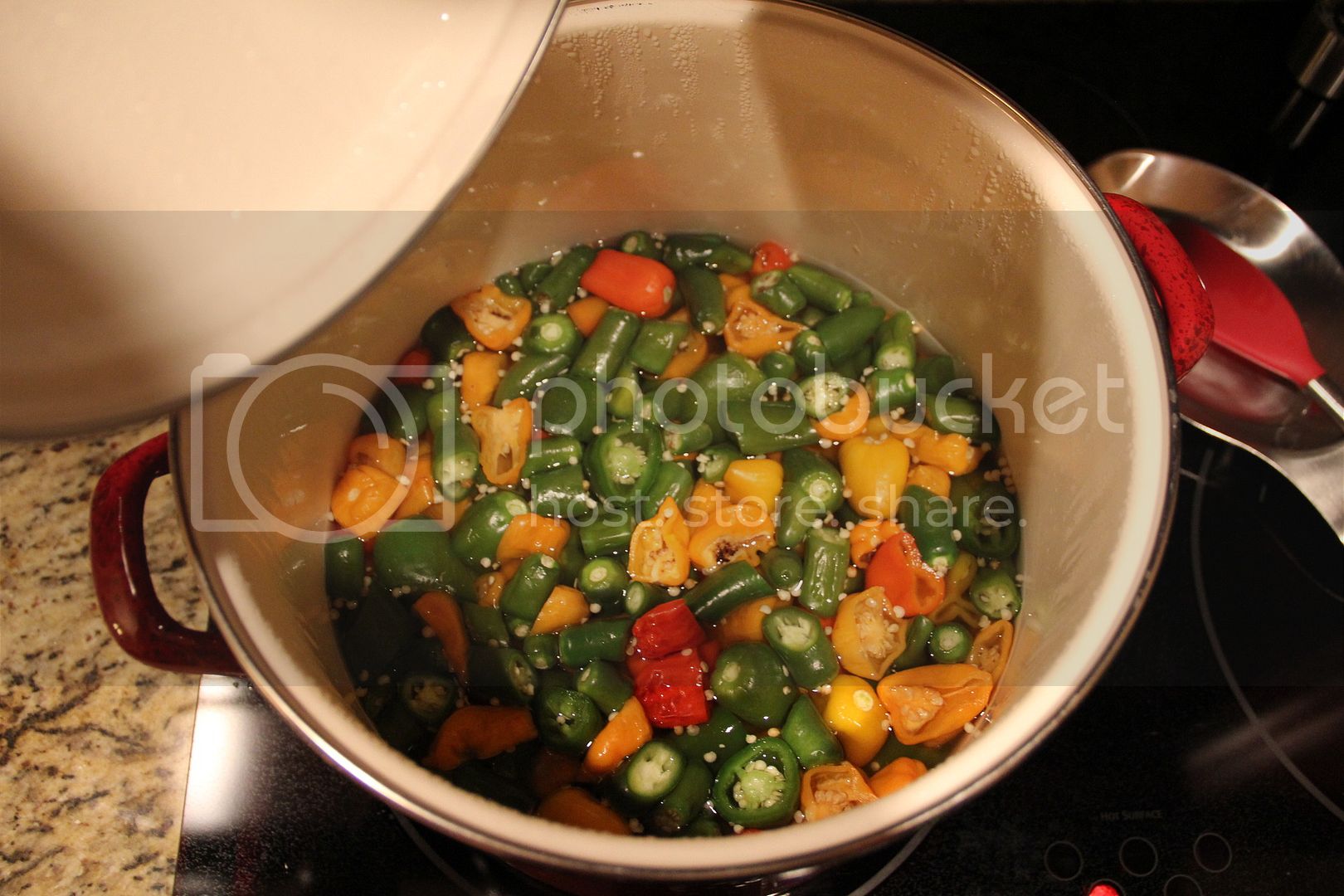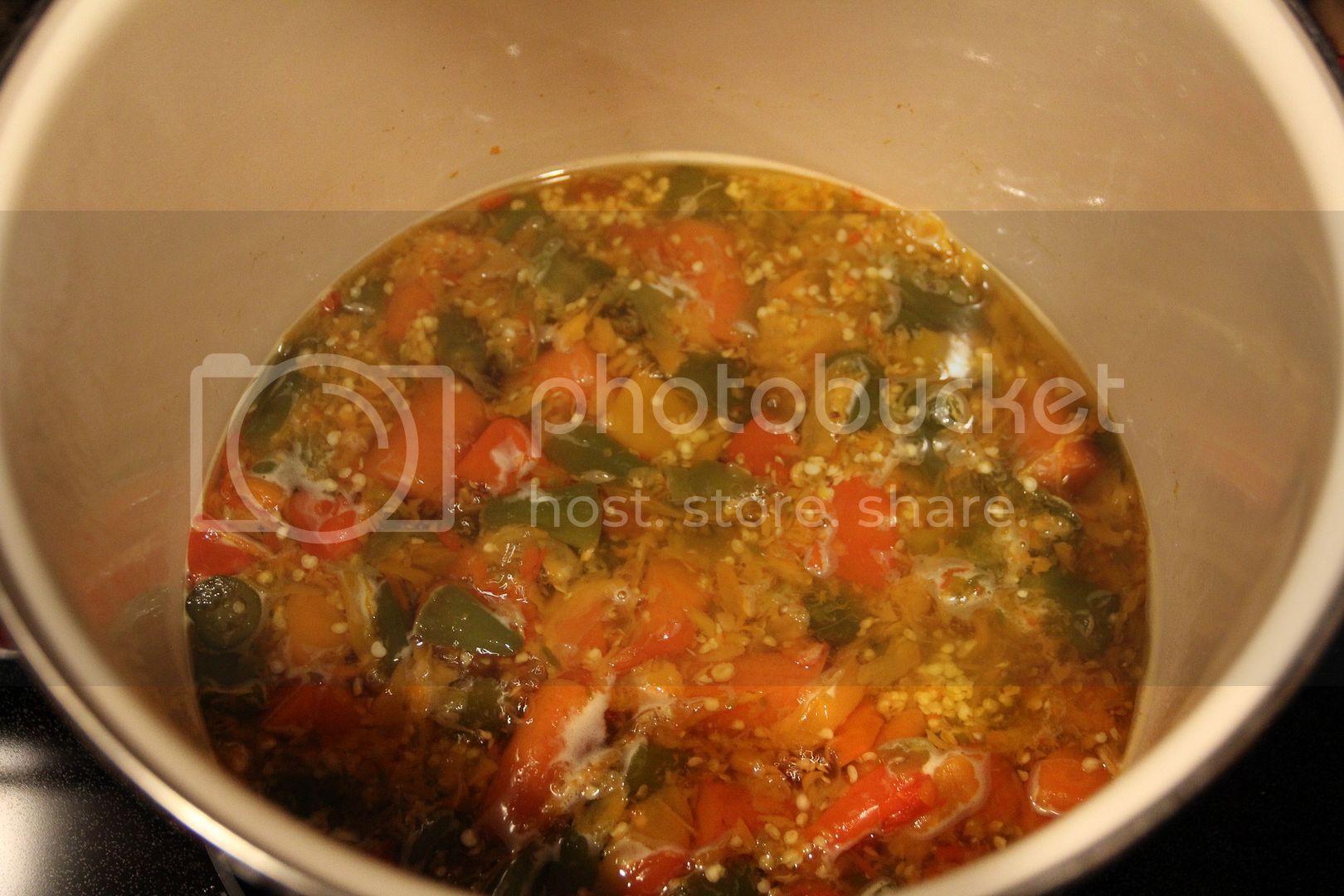-
If you have a question about commercial production or the hot sauce business, please post in The Food Biz.
You are using an out of date browser. It may not display this or other websites correctly.
You should upgrade or use an alternative browser.
You should upgrade or use an alternative browser.
fermenting Lactobacillus for fermentation
- Thread starter Abstract
- Start date
Hi Abstract and welcome to the THP
It's not really the Yogurt that you want but the whey from the yogurt. As RPM55 said look through the Fermenting Hot Sauce thread and you'll see how to collect it and use it.
Oh, and make sure you post pics of what your doing, we're all addicted to it!
Cheers
RM
It's not really the Yogurt that you want but the whey from the yogurt. As RPM55 said look through the Fermenting Hot Sauce thread and you'll see how to collect it and use it.
Oh, and make sure you post pics of what your doing, we're all addicted to it!
Cheers
RM
Here's what I've been up to today.
Hab's on the left...Serranos and Jalapenos on the right...Sweets in the upper right.

Cut up and cooking...

4 hours later...

I also got some 3 piece airlocks for fermenting...some yogurt for the whey...and a little raspberry balsamic vinegar (for good measure).
Is a TBS of canning salt per cup of water too much?
One pound of each: Habs, Jala's, Serranos, and the Sweet on the vines....also have a bunch of Carrots cut up in there.
12 cups of water
12 TBS of canning salt
Hab's on the left...Serranos and Jalapenos on the right...Sweets in the upper right.

Cut up and cooking...

4 hours later...

I also got some 3 piece airlocks for fermenting...some yogurt for the whey...and a little raspberry balsamic vinegar (for good measure).
Is a TBS of canning salt per cup of water too much?
One pound of each: Habs, Jala's, Serranos, and the Sweet on the vines....also have a bunch of Carrots cut up in there.
12 cups of water
12 TBS of canning salt
Just curious why did you cook for 4 hours before fermenting them? Usually they go in there raw.
LOL...Not sure. Maybe one of these?
A: Because I didn't understand the instructions.
B: Because my beer brewing roots took over.
C: Because I'm a n00b.
D: All of the above.
I boiled and pureed it then chilled it in the fridge overnight. This morning I added the yogurt whey and stirred it in well. Then I topped the whole mess off with more brine (let it sit on top).
Thoughts?
Let me know how it's going in 48 hours.

Predictions?
One last question, did you put everything in the fermenter liquid and all or just the solids that you pureed?
If you put everything in I think you'll have an aggressive start for maybe a couple of days followed by it looking like it's not doing anything.
If you only used the pureed solids then I think it's going to be a very slow fermentation with little activity.
Here's why I think this. the cooking will release alot of the sugars into the liquid. Since the sugars are more readily accessable it's going to make the Lacto go crazy and consume them rapidly. It then will then slow as only those residual sugars left in your ingredients remain and they'll have to work at getting at them. If you didn't incorporate the cooking liquid then you've poured off those sugars that were released during cooking so a slow fermentation. But, JMHO, I could be wrong.
If you put everything in I think you'll have an aggressive start for maybe a couple of days followed by it looking like it's not doing anything.
If you only used the pureed solids then I think it's going to be a very slow fermentation with little activity.
Here's why I think this. the cooking will release alot of the sugars into the liquid. Since the sugars are more readily accessable it's going to make the Lacto go crazy and consume them rapidly. It then will then slow as only those residual sugars left in your ingredients remain and they'll have to work at getting at them. If you didn't incorporate the cooking liquid then you've poured off those sugars that were released during cooking so a slow fermentation. But, JMHO, I could be wrong.
I actually let it cook a little long. It was a low boil for approx 6 hours.
I cooked 1 lb Habs, 1 lb serranos, 1 lb jalapenos, and 1 lb sweet on the vine peppers...also a bundle of carrots...with 12 cups water and 12 tbs canning salt.
Cooked all that down. Like WAY down. It didn't scorch...and it all fit in a normal blender in the end. no draining needed.
Once it was in the blender (temp hot) I added 5 oz of raspberry vinegar (5%) for good measure (and some flavor).
I pureed all that for minutes. All seeds were in tiny pieces at largest.
Put that in the fridge overnight because it was 3am and I didn't think it would be good to add lactobacillus to high temperature sauce. (Back to the beer roots where you pitch yeast into room temp wort)
In the morning the puree was cold and I added it to pickle jars (2)...just dumped the pickles and added the puree (I also added 1 whole fresh white hab to each jar...the two lighter colored ones in the lower left of the first picture) . I assumed the pickles were in a sanitary state...so that should suffice. (Thoughts?)
I poured about a 1/4 cup of yogurt whey to each jar and stirred until well mixed.
Then I made more brine...2 cups water and 2 tbs canning salt...and added a cup to sit on the top of each jar.
I didn't use airlocks...I just lightly screwed the lids on.
So far, I'm seeing some 'bubbles'...but they're not rising...they're just sitting there. The brine is still sitting on top. So far it doesn't look ruined. lol
Would you mind giving me a critique? I'm a big boy, I can take it.
I cooked 1 lb Habs, 1 lb serranos, 1 lb jalapenos, and 1 lb sweet on the vine peppers...also a bundle of carrots...with 12 cups water and 12 tbs canning salt.
Cooked all that down. Like WAY down. It didn't scorch...and it all fit in a normal blender in the end. no draining needed.
Once it was in the blender (temp hot) I added 5 oz of raspberry vinegar (5%) for good measure (and some flavor).
I pureed all that for minutes. All seeds were in tiny pieces at largest.
Put that in the fridge overnight because it was 3am and I didn't think it would be good to add lactobacillus to high temperature sauce. (Back to the beer roots where you pitch yeast into room temp wort)
In the morning the puree was cold and I added it to pickle jars (2)...just dumped the pickles and added the puree (I also added 1 whole fresh white hab to each jar...the two lighter colored ones in the lower left of the first picture) . I assumed the pickles were in a sanitary state...so that should suffice. (Thoughts?)
I poured about a 1/4 cup of yogurt whey to each jar and stirred until well mixed.
Then I made more brine...2 cups water and 2 tbs canning salt...and added a cup to sit on the top of each jar.
I didn't use airlocks...I just lightly screwed the lids on.
So far, I'm seeing some 'bubbles'...but they're not rising...they're just sitting there. The brine is still sitting on top. So far it doesn't look ruined. lol
Would you mind giving me a critique? I'm a big boy, I can take it.
Vinegar will kill the fermentation process. I've got starter cultures for bread making in my fridge.......some are pretty old, which is good. When I bring them back to life I don't use chlorinated tap water, the washing and the feeding is done with distilled. The yeast needs to feed and grow. You don't need vinegar, even in the final sauce making. As long as the ph is below 4.0 you'll be fine. If the fermentation is done correctly your ph should be low even when using using quanities of none acidic solids.
Vinegar will kill the fermentation process. I've got starter cultures for bread making in my fridge.......some are pretty old, which is good. When I bring them back to life I don't use chlorinated tap water, the washing and the feeding is done with distilled. The yeast needs to feed and grow. You don't need vinegar, even in the final sauce making. As long as the ph is below 4.0 you'll be fine. If the fermentation is done correctly your ph should be low even when using using quanities of none acidic solids.
What about vinegar kills the fermentation? I thought people here use it...but it's not required.
The lower PH isn't the problem...or else fermentation would never finish on any hot sauce.
Just curious.
I think cooking will also kill the fermentation process
I added the lacto after it cooled off.
+1 to Pic1
Here's the why:
Lactic acid is the dominant acid created by lactobacillus bacteria, during fermentation. Although acetic acid (vinegar) is also created, the proper ratio of lactic to acetic acids needs to be in a 4:1 ratio. Adding Vinegar then to a lacto-fermentation brine, disrupts that ratio, throwing the fermentation out of balance! The lactobacillus bacteria will be stunted, unable to develop the correct texture, flavor, or natural-preservative qualities that are desirable in lacto-fermentation. Vinegar should be added during the final processing of turning the mash into a sauce and only used for flavoring.
Lactobacillus bacteria – foundational to all fermentation processes – have complex nutritional needs and thrive on starches, amino acids, nucleotide bases, vitamins, minerals, fatty acids and carbohydrates. A few simple guidelines will ensure your lactobacillus bacteria are well-fed are:
for more information you can look at: http://www.pickl-it....enting/#faq_278
Here's the why:
Lactic acid is the dominant acid created by lactobacillus bacteria, during fermentation. Although acetic acid (vinegar) is also created, the proper ratio of lactic to acetic acids needs to be in a 4:1 ratio. Adding Vinegar then to a lacto-fermentation brine, disrupts that ratio, throwing the fermentation out of balance! The lactobacillus bacteria will be stunted, unable to develop the correct texture, flavor, or natural-preservative qualities that are desirable in lacto-fermentation. Vinegar should be added during the final processing of turning the mash into a sauce and only used for flavoring.
Lactobacillus bacteria – foundational to all fermentation processes – have complex nutritional needs and thrive on starches, amino acids, nucleotide bases, vitamins, minerals, fatty acids and carbohydrates. A few simple guidelines will ensure your lactobacillus bacteria are well-fed are:
Use high-quality fresh ingredients
Filtered water that doesn’t contain fluoride or chlorine (both kill lactobacillus bacteria)
Unrefined, high-mineral sea salts
Cover the fermentation Jar to block UV light
for more information you can look at: http://www.pickl-it....enting/#faq_278
I added the lacto after it cooled off.

True, but it would have killed off all natural lacto
It's still going.
I kept it in approx 70deg dark room for a week...then put into the attic over a few cool days.
There is some dried brine in the dish I'm holding the jars in...meaning I got some decent fermentation and sauce bubbled out.
The temps got hot today so I brought it back into the cool. I read that temps above 115 kill lacto. And that yogurt should ferment between 98 and 110.
I'll just do it slow...and yeah...I'm thinking it's probably WAYYYY too salty.
Peppers are cheap...I'll do it again and again and again until I get it right. :thu:
I kept it in approx 70deg dark room for a week...then put into the attic over a few cool days.
There is some dried brine in the dish I'm holding the jars in...meaning I got some decent fermentation and sauce bubbled out.
The temps got hot today so I brought it back into the cool. I read that temps above 115 kill lacto. And that yogurt should ferment between 98 and 110.
I'll just do it slow...and yeah...I'm thinking it's probably WAYYYY too salty.
Peppers are cheap...I'll do it again and again and again until I get it right. :thu:
Salt wise you would have been fine with a couple of tablespoons across all of them. Some like to use more but you really only need a touch to keep them safe till the lacto get started. When a starter is used they grt started right away and build quickly with all that food in there. If you want to remove some salt an old chefs truck is to add a whole peeled potato to it while it simmers and it will soak up some of the salt. Then just remove the potato and throw it away.
I've been making Kimchi for a few years now, and my .02 is that the lacto bacteria are naturally occurring on the outside of your veggies. Cooking will kill them, you just need to cut them up so the sugars inside are more readily available (increasing the surface area). Produce you buy in the markets are generally washed in chemical solutions to kill the flora on the outside and/or waxed to keep out oxygen. Both methods are intended to retard spoilage, and have a negative effect on the lacto bacteria... You'd have to add them back in then.
The easiest process for fermentation is to cut the peppers right off the plant. Do not wash. Dice up and fill a sanitized gallon vessel layering with sea salt (4% by weight) and mottling with a sterile utensel as you go to remove air pockets. I also scatter 1 tbl of raw cane sugar per 2 qts of solids. Fill pepper mix to within 2 1/2 from the top.
Use and air lock filled with alcohol not water. That keeps any competing bacteria from entering. Of course this is not lacto but wild fermentation. You can weigh the mix down with a heavy stoneware or cermic device, but its not necessary. Keep the jug in a plastic bag or box in a closet or basement area. The full process can take up to 3 months for mellow flavors to result.
Use and air lock filled with alcohol not water. That keeps any competing bacteria from entering. Of course this is not lacto but wild fermentation. You can weigh the mix down with a heavy stoneware or cermic device, but its not necessary. Keep the jug in a plastic bag or box in a closet or basement area. The full process can take up to 3 months for mellow flavors to result.

